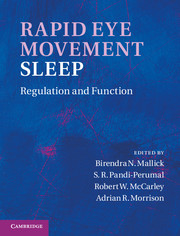Book contents
- Frontmatter
- Contents
- Contributors
- Preface
- Acknowledgments
- Organization
- Section I Historical context
- Section II General biology
- Section III Neuronal regulation
- Section IV Neuroanatomy and neurochemistry
- Section V Functional significance
- Section VI Disturbance in the REM sleep-generating mechanism
- 40 Narcolepsy and REM sleep
- 41 REM sleep and dreams: relationship to anxiety, psychosomatic, and behavioral disorders
- 42 REM sleep and emotion regulation
- 43 Neural modeling for cooperative/competitive regulation of REM sleep with NREM sleep and wakefulness
- 44 The selective mood-regulatory theory of dreaming: an adaptive, assimilative, and experimentally based theory of dreaming
- Index
- Plate section
- References
44 - The selective mood-regulatory theory of dreaming: an adaptive, assimilative, and experimentally based theory of dreaming
from Section VI - Disturbance in the REM sleep-generating mechanism
Published online by Cambridge University Press: 07 September 2011
- Frontmatter
- Contents
- Contributors
- Preface
- Acknowledgments
- Organization
- Section I Historical context
- Section II General biology
- Section III Neuronal regulation
- Section IV Neuroanatomy and neurochemistry
- Section V Functional significance
- Section VI Disturbance in the REM sleep-generating mechanism
- 40 Narcolepsy and REM sleep
- 41 REM sleep and dreams: relationship to anxiety, psychosomatic, and behavioral disorders
- 42 REM sleep and emotion regulation
- 43 Neural modeling for cooperative/competitive regulation of REM sleep with NREM sleep and wakefulness
- 44 The selective mood-regulatory theory of dreaming: an adaptive, assimilative, and experimentally based theory of dreaming
- Index
- Plate section
- References
Summary
Summary
REM sleep has the dream experience as a frequent if not inevitable concomitant. Questions arise about the construction, function, and meaning of this peculiar and puzzling experience. How are the dreams of the night organized? How do they relate to REM sleep and to each other across the night? How do they relate to waking consciousness? And, do they serve an adaptive function? I will describe the selective mood-regulatory theory of dreaming as an experimentally based attempt to answer these questions.
The beginning of our exploration of a function for dreaming is at the observation that dreaming and sleep disturbances may be related.
- Type
- Chapter
- Information
- Rapid Eye Movement SleepRegulation and Function, pp. 450 - 459Publisher: Cambridge University PressPrint publication year: 2011
References
- 1
- Cited by



